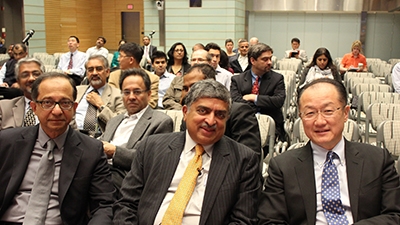Terms like ‘poverty-killer’ and ‘game changer’ are heard frequently in development circles, but when used by World Bank President Jim Yong Kim and Chief Economist Kaushik Basu, they acquire an additional degree of urgency and depth.
Kim and Basu were referring to India’s digital unique identification program, and the man who runs it – Nandan Nilekani, Chairman of the Unique Identification Authority of India.
For Kim, the ‘poverty killer’ aspect of the program is the promise of on the ground impact. For Basu, it’s the more efficient direct transfer of benefits to the poor and vulnerable that promises to be a ‘game changer.’
Nilekani was at the Bank on April 24 to give a lecture about the governments’ ‘Aadhaar’ project, an unprecedented effort to provide 1.2 billion Indian residents with a digital proof of identity. (‘Aadhaar’ means ‘foundation’ in several Indian languages).
Once they have an identity number, citizens will have an opportunity to participate in the formal economy, and government expenditures will become more efficient and equitable.
“Not having an identity historically wasn’t a problem in India because people stayed in their villages,” said Nilekani. “But today, this has become the source of a divide.”
Helping bridge this divide is the task of the Aadhaar project, and at the core of the project is an IT system that would have been impossible as recently as five years ago. In the past few years, ubiquitous connectivity, drastic reductions in the prices of smart devices, and internet-based computing, which has allowed the likes of Facebook to smoothly handle one billion users, have all dramatically opened up the opportunities for using IT in interesting ways.
As happened at Ellis Island during the early days of mass immigration to the United States, Aadhaar’s system records basic information about an individual like name, age and gender. But in a 21st century twist, it also scans fingerprints and eyes.
As a result, the system matches with 99.99% accuracy millions of names every night against the already-registered 300 million identities to ensure there are no duplicates. Moreover, the system is a simple platform that is easily scalable and can support other applications that may arise in the future (from other government agencies, as well as the private sector), in much the way that ‘apps’ are developed around smart phones.
Registrations have been growing at breakneck speed, with 380 million residents enrolled since September 2010, when the system was rolled out, and an additional million enrollments being added each day. The target is to enroll 600 million people by 2014.

